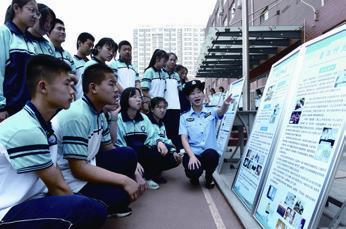War on Drugs
By Lu Yan



In October 2019, Peng Hongqing set a new record in Liupanshui, a prefecture-level city in Guizhou Province in southwest China. The record was for the largest ever seizure of illegal methamphetamines (meth).
Peng, 42, is the head of the anti-drug brigade of Liupanshuis Liuzhi Special District Public Security Bureau. Having worked as a police offi cer for 21 years, he has dealt with many of the citys drug crimes, fighting a battle of wits and courage against drug dealers.
Peng and his team arrested five drug trafficking suspects during the October operation and seized 69.2 kg of crystal meth. Three months after that, he led his team to crack a case of interprovincial drug smuggling, seizing 33.9 kg of meth tablets.
In June, he was commended as one of the outstanding individuals contributing to the nations anti-drug work.
“I will continue to work on the frontline against drug crimes so that people do not fall victim to narcotics,” Peng said.
Significant results
Numerous heroes like Peng and governments at various levels in China have made anti-drug efforts, maintaining social harmony and stability, and protecting the people and their livelihood.President Xi Jinping called for a peoples war against drugs to make new progress in drug control.
He made the remark in a directive to a conference held on June 23 to commend outstanding organizations and individuals contributing to the nations anti-drug work, including Peng. The conference was held ahead of the International Day Against Drug Abuse and Illicit Traffi cking, June 26.
Significant results of the anti-drug campaign can already be observed. In June, the China National Narcotics Control Commission released a report on the annual drug situation, saying that drug control in China has improved despite daunting internal and external threats.
By the end of 2019, China had about 2.15 million drug users, down 10.6 percent year on year, the report says.
The number of current drug users has fallen in the past two years, and the number of recovering drug users who have not relapsed since treatment has also increased over several consecutive years.
However, Chinas anti-drug program still faces severe challenges. The report says that drug use has become more covert, making it harder to investigate. Drug abuse in public entertainment venues has decreased, with drug users increasingly choosing to take drugs in private locations such as hotels, apartments, private clubs or private cars.
Some drug addicts establish “friend circles” via social media, communicating with fake identities and codewords, and forming more subtle networks.
The commissions report additionally stated that an increase in the variety of drugs in China is creating challenges to law enforcement officials in identification and seizure.
Drug abuse poses serious hazards to public security. It not only brings serious harm to users and their families, but also leads to other criminal activities such as theft and robbery. Long-term abuse of synthetic drugs can lead to mental illness.
According to the report, while the antidrug program has been effective in curbing the domestic production of illegal narcotics, the amount of drugs arriving in China from overseas has been increasing. Of the 65.1 tons of drugs seized last year, 35 tons were believed to have come from overseas, a 7.5-percent increase year on year. This is seen to be the result of decreasing domestic drug production and the rising price of domestically produced drugs.
Currently, the Golden Triangle, an area notorious for its association with drug production and trafficking, is the main source of foreign drugs cited in the report. In 2019, the Golden Triangle, which borders Yunnan Province in southwest China, supplied 82.7 percent of the heroin, methamphetamines, ketamine and other major drugs seized across China.
The report also stated that legalization of cannabis in some European and North American countries has brought about an increase in the number of foreign employees, international students, and overseas returnees purchasing cannabis products and shipping them overseas.
Smart solutions
Just as drug crime has become more sophisticated in China, so too have the countermeasures put in place. High-end technologies and equipment are used in the anti-drug program, such as unmanned aerial vehicles (UAV), advanced detection technology and smart robots.Recently in Botou, a city in Hebei Province in north China, a reconnaissance UAV spotted an abandoned farm covered with plants suspected to be poppies. Local police took swift action and rushed to the scene. The plants turned out to be 146 poppies a local farmer had planted to treat his leg problem. The farmer had heard that soaking his leg in a preparation made from poppies could relieve his pain.
The police cleared the plants on the spot, and educated and penalized the villager.
Reconnaissance UAVs can detect hidden places that humans have difficulty reaching, and identify illegal narcotic plants, saving time, labor and costs.
According to Pan Yang, head of the AntiDrug Squad at Botous Public Security Bureau Criminal Police Brigade, the UAVs can penetrate branches, barbed wire and coverings to identify narcotic plants.
According to Pan, software used by the UAV system can identify illegal drug crops in an area of less than 30 square centimeters, even when that area is surrounded by green onions.
During a 16-day aerial survey begun in midMay, UAVs helped the police fi nd and eliminate 281 poppy plants growing at fi ve planting sites. The five people who illegally planted the poppies were punished.
Robots used in anti-drug campaigns have been reducing the labor of specialized anti-drug staff in Zhijin County in Guizhou. The robots are able to administer regular urine tests, remind addicts to attend rehabilitation and former addicts to participate in return visits and talks. They can conduct surveys and psychological tests, and collect employment and unemployment information.
Information collected by the robots is analyzed by intelligent terminals, further reducing the workload of anti-drug staff.

Liu Enxian, a local anti-drug official in Zhuzang, a town in Zhijin County, said now they can devote more time to visiting former addicts, learning about their status and coming up with solutions to meet their needs.
Similarly, in Shenyang, the capital city of Liaoning Province in northeast China, the local anti-drug department has launched an app for addicts in rehabilitation centers.
With the app, addicts can complete regular check-ins, communicate with anti-drug workers, and report urine test dates so that anti-drug workers know their situation and can better provide help.
“Big data provides technical support for drug rehabilitation, ultimately helping former drug users integrate into society and return to normal life,” said Lu Jiahui, an official with the Shenyang Narcotic Control Offi ce.
Lu believes that the anti-drug work should rely not only on the crackdowns by law enforcement, but also on social management and services.

